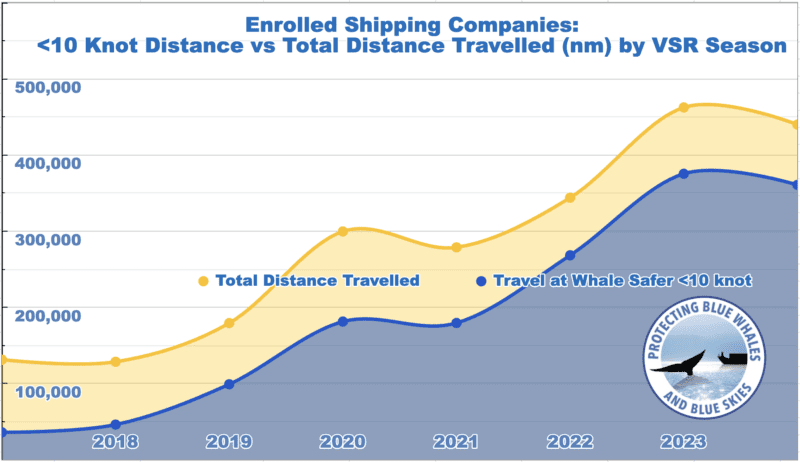Controlling Consequences in the Wake of a Marine Casualty
Selecting a Maritime Attorney USCG Marine License Insurance Well, you almost made it through your merchant mariner career without any issues. But fate had other plans, you ‘ran out of...
Voluntary partnerships and collaborative oversight address complex environmental issues.
Protecting Blue Whales and Blue Skies, a vessel speed reduction program for safer whales, cleaner air, and a quieter ocean, has released a mid-season report on the 2024 season, which runs May through December. The program reports the largest number of shipping lines participating in the history of the program, with 37 companies enrolled and 14 achieving the highest recognition level. Those enrolled represent the majority of shipping traffic visiting California ports.
Each year for the past decade, the Protecting Blue Whales & Blue Skies program has incentivized increasing numbers of eligible shipping lines to voluntarily adjust shipping schedules to transit at 10 knots in key areas during times of peak whale presence and periods of high ground-level ozone (smog) concentrations.
Mid-Season Report
Twice a year, at the mid-year mark in September and end-of-season mark in December, data from enrolled shipping companies are evaluated, based on the percent of distance traveled by their vessels through the Voluntary Speed Reduction “VSR” zones at whale-safer speeds (10 knots or less).

The Issue
Ship traffic poses significant collision risk to whales. Off the West Coast alone – a major entry point for international goods to the United States – an estimated 80 whales a year are struck and killed by ships. The volume of commercial shipping has grown over the past decades to the point that ship noise now makes a larger contribution to ocean noise than natural sound sources for many ocean locations, and dominates the ocean soundscape.
Jess Morten, California Marine Sanctuary Foundation’s Director of Marine Resource Protection, who has helped administer the program for the last eight years, reflects on the mid-year results, efforts to bring more shipping lines on board, and the program’s potential for sustained conservation impact.
“If you look at the progress of Protecting Blue Whales and Blue Skies, it’s really encouraging to see steady growth in the number of global shipping lines enrolling in the program, and the continuing cooperation of those shipping lines,” she said.

In terms of understanding the overall impact, Tim Mitro, Air Quality Engineer with the Santa Barbara County Air Pollution Control District, ran the numbers at the close of the 2023 season to get a sense of the scale of Protecting Blue Whales and Blue Skies’ efforts relative to all transits from eligible vessels (container, auto carrier, bulk, and tanker vessel operators).
“Looking at the total nautical miles from all ships transiting through the VSR zones, the participants in the program currently represent 89% of the container and auto carrier traffic,” he said. “As for the bulk and tanker vessels, the program recently expanded into these ship sectors and so the capture rate is only at 17%. More companies continue to sign up every season as they become aware of the program and the expansion in eligibility.”

Documented performance
To date, performance of enrolled participants halfway through the 2024 season includes:
The 14 shipping lines currently tracking in the top “Sapphire” tier include CMA CGM, COSCO Shipping, CSL, Dockendale, HMC Ship Management, Marathon Petroleum, MSC, NYK Ro-Ro, ONE Line, OOCL, OSG, Starbulk S.A., Swire Shipping, and Yang Ming.
How the Program Monitors Shipping Activity to Verify Results:
Automatic Identification System (AIS) is a coastal tracking and navigation safety system used on vessels that provides identification and positioning information, yielding information on each ship’s speed and location. The program synthesizes this AIS data from each ships’ transponder, analyzing information for each fleet to verify performance down to the ship level on specific transits. Supported by program partner Benioff Ocean Science Laboratory, Protecting Blue Whales and Blue Skies provides monthly reports to each shipping line, which yields increased visibility on performance and time to improve overall cooperation, as well as a breakdown of detected whale activity.
About the Program
Ship strikes are a major threat to whales globally, and specifically in California waters. They threaten the recovery of endangered blue, fin, and humpback whales. The 10-knot target complements NOAA, U.S. Coast Guard, and Environmental Protection Agency voluntary requests for all vessels 300 GT or larger to reduce speeds during the months of peak air pollution and endangered blue, humpback, and fin whale abundance to protect them from ship strikes.
Protecting Blue Whales and Blue Skies is a collaborative effort by the California Marine Sanctuary Foundation; Ventura County Air Pollution Control District; Santa Barbara County Air Pollution Control District; San Luis Obispo County Air Pollution Control District; Monterey Bay Air Resources District; Bay Area Air Quality Management District; Channel Islands, Monterey Bay and Greater Farallones/Cordell Bank national marine sanctuaries; The Volgenau Foundation; National Marine Sanctuary Foundation; Greater Farallones Association; Environmental Defense Center; Point Blue Conservation Science; Benioff Ocean Science Laboratory; Starcrest Consulting; and Scripps Whale Acoustic Laboratory/Scripps Institution of Oceanography.
For shipping companies and bulk operators interested in learning more, contact Jess Morten at [email protected]. For logistics companies, freight forwarders, ports and product companies interested in learning about our Ambassador program, contact Becca Tucker, at [email protected].

Sign up for gCaptain’s newsletter and never miss an update

Subscribe to gCaptain Daily and stay informed with the latest global maritime and offshore news


Stay informed with the latest maritime and offshore news, delivered daily straight to your inbox
Essential news coupled with the finest maritime content sourced from across the globe.
Sign Up